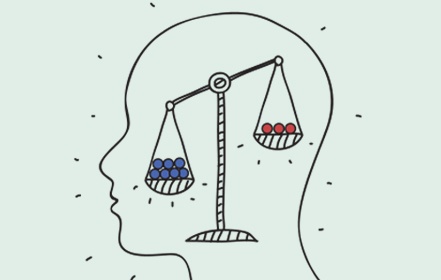Working with Depression
Depression is one of the most difficult illnesses to overcome. And for many clients, it can feel like their depression will never go away. So how can we disrupt a vicious cycle of depression when it’s limiting a client’s life?
In many ways, depression is like a fever. The symptom is simple enough to recognize, but it can be the result of many different causes.
And just like how an infection is treated differently than the flu, there is no one-size-fits-all treatment for depression. So as therapists, we have to be careful to consider all the mechanisms that might be driving a client’s depression — and that there may be multiple factors involved.

5 Common Causes of Depression
Depression can be caused by any number of reasons, ranging from medical to social.
Here are 5 of the most common sources of a client’s depression – and some strategies we can use to help relieve each:
1. Systemic Racism and Discrimination
According to Joan Borysenko, PhD, “The stress that we carry from being ‘other,’ in any way whatsoever, contributes enormously to our mental health and our physical health.”
Now, due to the social nature of human development, it makes sense that we would be wired to have a stress response in the face of being othered. As Daryl Rowe, PhD says, “Being a person is fundamentally a social activity, so belongingness is essential to optimal human functioning.” But this isn’t where impacts on mental health stop.
You see, humans also have an evolutionarily based tendency to categorize and generalize, and as you know, even the most adaptive responses can become problematic. This is no exception.
In an age of mass media, stereotypes are as prevalent as ever — with even less opportunity for escape. And according to Shelly Harrell, PhD, after a lifetime of receiving these cultural messages, many clients begin to internalize these value judgements into a personal sense of self-worth.
So, in treating depression with a basis in stereotypes or discrimination, we have to break the cycle of oppression within the therapeutic relationship. First and foremost, that means we have to establish the therapy office as a safe environment to discuss experiences of discrimination.
This may include strategies such as asking about experiences of discrimination at intake rather than waiting for a client to bring them up. It also requires examining personal biases — and the euro-centrist nature of commonly taught therapy techniques.
By making an active effort towards becoming an antiracist practitioner, we can better help all clients get the most out of therapy.
2. Traumatic Stress
Racism and other forms of discrimination are certainly one type of traumatic stress our clients may experience; however, many other traumatic experiences can also play a role in driving a client’s depression.
Take, for example, attachment trauma.
 Whether it’s abuse or neglect from an early caregiver, it’s easier for a child to blame themselves than to accept the dangerous notion that the person they rely on is incompetent. So, they often internalize feelings of never being good enough.
Whether it’s abuse or neglect from an early caregiver, it’s easier for a child to blame themselves than to accept the dangerous notion that the person they rely on is incompetent. So, they often internalize feelings of never being good enough.
Trauma also invites shame, which is a significant factor in perpetuating the cycle of depression. Paul Gilbert, PhD, recommends using a visual model of the threat systems to help clients understand why they reacted the way they did. He also suggests several strategies rooted in compassion-focused therapy, including fostering curiosity to help address shame.
On the other hand, Elisha Goldstein, PhD, describes depression as “the ultimate avoidance strategy.” So, in treating depression with a basis in traumatic stress, the key is to address the trauma itself using trauma therapy techniques individualized to the specific needs of the client.
After all, by helping clients process the trauma underneath, the avoidance is no longer necessary.
3. Gender Stereotypes
Of course, similar to other forms of discrimination, sexism can impact a client’s sense of belonging and self-worth. However, another way gender can impact depression is a little more subtle: the manner in which it is presented.
Now, there are a few key symptoms we tend to think of as universal signs of depression: fatigue, feelings of worthlessness, loss of interest in things that were previously enjoyable. But according to Terry Real, MSW, LICSW, while those symptoms are common with overt depression, there is another presentation which is a bit more covert.
You see, there is a lot of stigma surrounding vulnerability and weakness for men — stigma which can induce feelings of worthlessness at even a moment of vulnerability. As such, when men experience depression,[1] they have a tendency to hide their shame with grandiosity. So, in this covert form of depression, we are more likely to notice the defense mechanisms — self-medication, anger, violence, womanizing, etc. — rather than the depression itself.
But, as Terry explains, the key to healing covert depression is actually overt depression. In other words, addressing the defense mechanism will help reveal the depression that’s driving it, even when the client struggles to accept that it’s there.
And once the depression itself has been revealed, we can begin to implement both our individualized and more common, evidence-based interventions.
4. Cognitive Predispositions
Unfortunately, cognitive factors – including everything from personal values to topics of interest – can influence a client’s vulnerability to depression.
 A 2009 study by Sara Romens, PhD, Lyn Abramson, PhD, and Lauren Alloy, PhD, even suggests that tendencies toward negatively interpreting life events solidify during early childhood.
A 2009 study by Sara Romens, PhD, Lyn Abramson, PhD, and Lauren Alloy, PhD, even suggests that tendencies toward negatively interpreting life events solidify during early childhood.
Of course, not everyone with predispositions towards depression will actually experience it, but it’s important to pay attention to key indicators, such as distorted thinking.
There are numerous ways in which thoughts may be distorted,[2] including:
- Personalization: incorrectly assuming responsibility for or relevance to a situation.
- Overgeneralization: applying a conclusion from one situation to future scenarios, regardless of relevance.
- Polarization: taking an all-or-nothing or black-and-white perspective of the world.
But even though these cognitive patterns that drive depression can be deeply ingrained in a client’s personality, there are still many options for treatment.
For example, a recent multi-disciplinal study suggests a combination mind-body-spirit intervention may serve as a powerful defense against depression and anxiety. The example given by Ruth Tanyi, DrPH, and her research team involved muscle relaxation exercises, guided spiritual imagery, and humor along with standard cognitive-behavioral therapy approaches.
5. Biological Predispositions
Many clients will note that difficulties with depression or other mental illness seem to run in the family – and often, they’d be right.
Certain aspects of mental health have been associated with genetics. In fact, some researchers believe it may even be possible to predict a client’s threat response based on DNA indicators.
But just as with cognitive predispositions, being biologically more susceptible to depression is not a guarantee of experiencing it. . . and not having biological predispositions to depression isn’t invulnerability.
A certain amount of psychoeducation about depression on a neurobiological level can help clients reduce the shame and self-blame associated with it. But, we also have to be careful not to let clients buy in to the chronic disease narrative because if a client believes their depression to be chronic, they will likely lose hope for treatment.
The Neuroscience of Depression
 Neuroscience has come to the forefront of recent research on depression. After all, depression is often colloquially described as a chemical imbalance in the brain. People may think of it as a recipe: if you don’t have the right balance of sugar and salt, the cookies won’t taste right. But while this explanation gets part of the point across, the reality is much more complex.
Neuroscience has come to the forefront of recent research on depression. After all, depression is often colloquially described as a chemical imbalance in the brain. People may think of it as a recipe: if you don’t have the right balance of sugar and salt, the cookies won’t taste right. But while this explanation gets part of the point across, the reality is much more complex.
You see, depression is not just rooted in two or three chemicals. There are millions of combinations of factors in the brain alone — which means it’s rarely so simple to fix as adding a bit more sugar. So, while medication may be helpful, the neuroplasticity of the human brain leaves us with many other options for depression treatment.
As many of you know, any experience someone has, positive or negative, causes their neurons to fire. When those experiences are repeated, the same patterns of neurons fire again, strengthening the connections. The brain learns from this sort of conditioning, developing automatic habits for responding to life events.
According to Linda Graham, MFT, this process is the key to resilience.
When someone has had a history of secure attachment, a caregiver’s response to their childhood distress often conditions a sense of reassurance and safety, allowing for a greater tolerance for distress later in life.
Unfortunately, many clients weren’t able to develop resilience through attachment in this way. So in therapy, we can help clients with reconditioning, or overriding the maladaptive defenses associated with depression in order to foster resilience.
For example, by having a client consciously reframe their distorted thoughts during a session, they will begin to build new neurological connections. Once these connections have been sufficiently reinforced through practice, this will form a habit of reframing distorted thoughts. In this way, we’ve built a first defense against the patterns which sustain depression.
When Depression Feels Like a Life Sentence
Many clients report feeling as though their depression will last their entire life.
But let’s think, for a moment, about someone who has never experienced depression. They know it exists — perhaps they have a friend who is depressed, or they’ve read about it, but they have never felt it.
Well, humans are predisposed to make assumptions. Once upon a time, it was evolutionarily advantageous to project past experiences onto the unknown. So, when this person hears about depression, they draw on the most similar thing they can think of to try to empathize: sadness.
Now, with sadness, people tend to have a sense that the emotion is transitory. It’s part of a fluid process. It feels bad now, but it won’t last forever. That’s why people commonly use hopeful phrases like, “Just give it some time,” when talking to their friends facing depression.
But unlike sadness, depression comes with a sense of permanence. Which, often, means that overtly offering hope can be perceived as an empathic failure.
So how can we help clients shift out of this sense permanence?
Well, even the language we use to discuss depression can impact a client’s hope.
Take, for example, the phrase, “You are depressed.” This inadvertently implies the depression to be a character attribute, not unlike, “You are kind,” or, “You are smart.” So even variations on this, like asking, “What does it feel like when you are depressed?” can imply that depression is implicitly part of the client — meaning, there is no hope for relief.
If, on the other hand, we use phrases such as, “When depression comes to visit,” or “When depression shows up,” this externalizes it, making it seem more transient and manageable.
Using Physical Exercise to Treat Depression
One of the most common suggestions for helping people relieve depression is to exercise.
 But as Christine Padesky, PhD, has said, people don’t stay depressed from a lack of good advice. In fact, they often have family and friends suggesting they exercise, or even just get out more. The problem is, for someone experiencing depression, it isn’t so easy.
But as Christine Padesky, PhD, has said, people don’t stay depressed from a lack of good advice. In fact, they often have family and friends suggesting they exercise, or even just get out more. The problem is, for someone experiencing depression, it isn’t so easy.
Let’s start, for a moment, by thinking about someone who suffers from asthma. Generally, if they begin to feel indications in their body that what they’re doing is straining their body, particularly if it is causing trouble breathing, they aren’t likely to continue to overdo it.
But with depression, people often feel like they need to push themselves, and there is often a social pressure to do so. And there are serious impediments to doing that, the least of which being discouragement or shame from a lack of results.
That being said, exercise is still one of the most effective ways to help clients improve mood — we just have to start at a slightly more realistic pace.
According to Kelly McGonigal, PhD, one of the biggest barriers for clients starting out is the word “exercise” itself. After all, exercise is associated with being fatiguing, or taken to a point of exhaustion. Instead, she suggests the word “movement.”
Of course, there are so many types of movement, what is actually best for treating depression?
Well, to put it simply, it’s whatever the client will actually do.
Studies have shown that even just a five-minute walk each day can be a foot in the door. In fact, Kelly described one study in which people were given a gym membership and were asked to go once a week. Many clients began to exercise multiple times a week, and also eat healthier, even without being asked.
As it turns out, willpower is contagious.
How Mindfulness Can Help Relieve Depression
Another key strategy for creating natural anti-depressants is one which has been applied to many areas of psychotherapy: mindfulness.
According to Elisha Goldstein, PhD, there are many reasons why mindfulness strategies can be so effective.
To start, depression lives in the parts of the brain associated with rumination. Now, many psychotherapy techniques involve introspection and discussion of narratives. But, as Lynn Lyons, LICSW, points out, it isn’t helpful to mimic what the disorder is already good at. Most mindfulness practices, on the other hand, activate the parts of the brain associated with sensing the world, inherently shifting focus from the past-oriented depression towards the present.
Familiarity with mindfulness also opens up the opportunities to learn other self-regulation techniques, such as those based in compassion-focused therapy. You see, according to Elisha, self-compassion is inversely correlated with depression.
Moving Forward with Depression Therapy
Unfortunately, depression tends to be recurring. Most people who have had an episode of major depression will experience depression again in the future.
That’s why it’s so important that even if a client seems to have recovered, we continue to resource them with strategies to help them stay well throughout their lives.
References
Want more ideas and strategies you can use with your clients today?
To learn more about the latest strategies for treating depression, check out one of our courses:

How to Work with the Patterns That Sustain Depression
3.75 CE/CME Credits Available

How to Work with Clients Who Struggle with an Inner Critic
4 CE/CME Credits Available

Working With Core Beliefs of “Never Good Enough”
4 CE/CME Credits Available

Experiencing the Life-Changing Transformation of True Resilience
2 CE/CME Credits Available